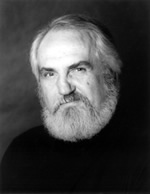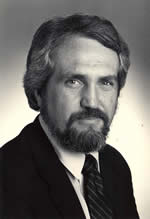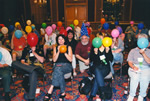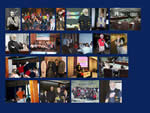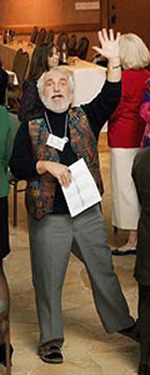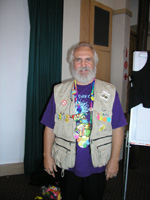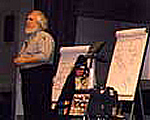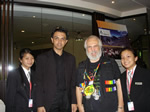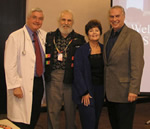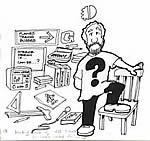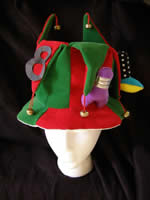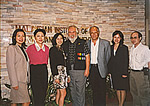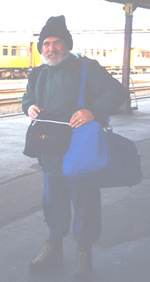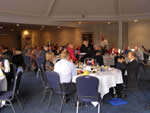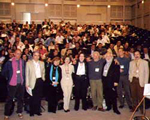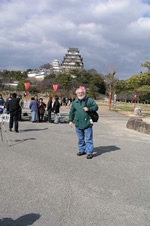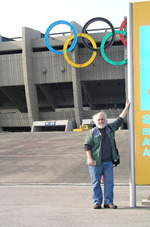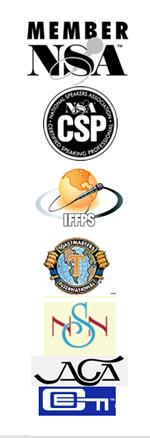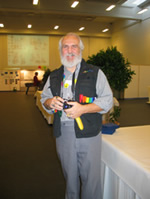Each of the following programs has been designed in 3 formats
1. 45 to 60 minute Keynote Address
2. 60 to 90 minute Concurrent or Breakout Session
3. 2 to 4 hour Workshop
TITLES - scan down for descriptions/outlines/schedules
LEADING
NOAH HAD IT EASIER© - Leading Those Who Don't Want to be led.
From Attila to Zorro! - Leading Styles that Work
COMMUNICATING
If You Shoot from the Hip, You Aim to Miss
YOU MIGHT AS WELL BE SPEAKING & WRITING IN TONGUES© - Communicating More Successfully Today
TEAMING
WE KEEP MISSING THE HOOP! Stop Being Just a Group and Become a Successful T*E*A*M
TEAMING CATS©
Turning a Group into A team Effectively Today
CRE8NG!
GETTING TO EUREKA! & BEYOND............
THOUGHTS - IDEAS - SOLUTIONS
BROKEN CRAYONS - S.P.R.E.A.D.ng Creative Thinking Throughout Your Entire Organization
SOLUTIONS REQUIRE DOZENS OF DOZENS OF IDEAS FIRST©
Turning any department or company into a Solution Focus Team
DESCRIPTIONS
LEADING
NOAH HAD IT EASIER©
Leading Those Who Don't Want to Be Led
Today's workplaces consist of some of the greatest diversity of people in history. The Great Generation, who survived the Depression and saved the world in WWII, War Babies, Boomer Generation, Generation X, Generation Y, Millennium Generation and the greatest influx of a single group of immigrants (legal and illegal). All these bring great challenges to the workplace for supervisors, team leaders, managers, leaders need to deal with. This program has been designed to provide tools and techniques for effectively leading, guiding, coaching, counseling highly diverse workplaces.
Learning Outcomes (measurable behavior or performance objectives):
Participants will:
1. learn more about their most productive leadership style
2. will work with a series of tools for better understanding today’s employees
....a. Mind Design
....b. Values System
....c. Behavior Patterns
....d. Who Are These People?
3. learn approaches for expanding effectively their roles as leaders:
guiding, facilitating, coaching, counseling. Managing,
even Bossing when necessary
4. experiment with a mix of Leadership Styles
COMMUNICATING
If You Shoot from the Hip, You Aim to Miss
Too often we all communicate like gunslingers, we 'shoot from the hip'. We need to focus and plan our communications to increase understanding and success. You/we can plan, organize and design what you/we are going to say when walking down a hallway or across a room. This session will help you learn to better plan and improve your communications, whether written or spoken, in person, on the phone, over the internet or the mail. Stop shooting from the hit and improve your communication.
Shoot from the Hip
Learning Outcomes (measurable behavior or performance objectives):
Participants will:
1. learn 7 techniques for organizing their thoughts to communicate
2. discover what are some of your communicating strengths to add to them
3. learn how to take talking to speaking to improve your communication at work
4. examine how to DESIGN what you say to improve communication
Presentation Outline (sample 75 minute schedule)
5 - Opening
10 - The Many Ways We Communicate?
15 - 32 Causes causes mis-communication?
10 - Using 6 Ps of Productive Public Speaking
Planning, Preparation, Practice, Present, Place, People,
15 - Planning Our Communications
....Tell, Tell, Tell
....Historic
....Opening Content Closing
....Past Present Future
....Good Aspects - Concerns - Possibilities
15 - Understanding Our Audiences/Listeners/Readers
....MIND Design
....Values
....Behavior Patterns
5 - Closing - What Can We Do From Now On to Improve Even More?
YOU MIGHT AS WELL BE SPEAKING &
WRITING IN TONGUES©
Communicating More Successfully Today
$3 Billion is probably wasted in our workplaces every day due to small to medium communication errors. This session is filled with tips, techniques and systems for improving you speaking, listening and understanding and communicating with all people from the front door to the executive floor of your organization. Using the S.T.I.R. process, understanding 36 Causes of Mis-Communication, learning how to use the M.I.N.D. Design thinking/learning/communicating/problem solving model to minimize the majority of your communication challenges.
Learning Outcomes (measurable behavior or performance objectives):
Participants will:
1. explore and analyze 36 major sources of Mis-Communicatiion
2. learn the S-T-I-R approach to More Successful Communication
3. learn about their personal communication style and how it impacts their communication
4. learn how to communicate in a variety of styles to improve communication.
TEAMING
WE KEEP MISSING THE HOOP!
Stop Being Just a Group and Become a Successful T*E*A*M
People gather. They cluster. They form groups accidentally, intentionally or by plan. When they grow into a T*E*A*M is when they become focused and successful. Too often we act like groups instead of working like TEAMS. This session will help you better understand the differences between being a chaotic unsuccessful group and how to become a dynamic and successful TEAM.
Team people more successfully. . .
Turn your group of individuals into successful teams (small to entire organization)
Teaming Successfully program outlines and descriptions below
MIND Design ..questionnaire...Better Understand how to team your people
Learning Outcomes (measurable behavior or performance objectives):
Participants will:
1. learn techniques for turning groups into teams
2. experiment with differences between groups and teams
3. learn a mix of techniques for developing more teamwork in the workplace
4. examine their current team effectiveness compared to its potential
Presentation Outline (sample 75 minute schedule)
5 - Opening
10 - Americans Hate to Work in Groups, Yet Make the Best Teams When Needed usually in times of Chaos)
5 - Team/Group Exercise
....i.e.: Index card exercise
5 - Who are these people?
10 - Who is this team?
....MIND Design
....Values
....Behavior Patterns
....How are we different?
....How are we diverse?
....How are we the same, common?
5 - Define groups, teams
10 - Characteristics of successful teams
10 - Are We a Team Yet?
....i.e.: Gordian knot
10 - What causes us to keep missing the hoop?
5 - How might we create teams among this group?
....Age, experience, education, titles, awards, honors, skills, abilities, roles, reputations
5 - Summary and Where Do We Go From Here
TEAMING CATS©
Turning a Group into A team Effectively Today
Many jokes have been told about how TEAMING AMERICANS is like HERDING CATS. In many ways that is often the case. Seldom throughout our school years are we taught how to be team members or how to lead teams unless we play organized sports and even then we don't receive much real team training. Perhaps if we play sports we learn some things there is no guarantee. Yet seldom the learnings are more than purely accidental side results and not direct lessons. Then in our workplaces we expected to become strongly effective, caring, devoted, team members.
Not Invented Here
Not In Our Department
That's Not My Job
Theses are almost paradigms in the minds and hearts of too many people and organizations.
We all can learn to become Strongly Successful Team members.
We all can learn how to better lead Successful Teams
Evidence continually shows that diverse groups of people can work effectively in team-like manner when chaos or tragedies happen. Hurricanes, terrorist attacks, earthquakes, forest fires all provide examples how most people can step forward and work in spontaneous teams. Yet most of them in their every day lives rarely work in teams.
This session is planned to help even the most team resistant people accept and begin to appreciate the value of learning to become more team-like and become members of teams.
CRE8NG!
GETTING TO EUREKA! & BEYOND............
THOUGHTS - IDEAS - SOLUTIONS
We have thousands of thoughts. We need to generate hundreds to thousands of ideas to generate or find great solutions. In the end it is solutions we truly need. This session will teach you a dozen ways to generate hundreds of ideas and not just a few dozen thoughts in your meetings. Then once you have the ideas you need you need a system to turn them into solutions.
Learning Outcomes (measurable behavior or performance objectives):
Participants will:
1. learn 32 ways to improve creative thinking skills in ALL employees
2. experiment with 12 different idea generating tools and techniques
3. learn a mix of techniques for setting up a more creative environment that will increase the quantity and quality of ideas that employees generate.
4. learn 4 tools and systems for narrowing down large numbers of ideas in order to create plans to reach true solutions.
BROKEN CRAYONS - S.P.R.E.A.D.ng Creative Thinking Throughout Your Entire Organization
The fastest way to begin generating new ideas is to break old ones, break old ways of thinking, seeing, feeling....break paradigms...they way you have done things for a long time. Every human being is born with the capacity to think creatively. Unfortunately conventional wisdom and thinking tells us to stop and we stop. In our workplaces today we need more creativity than we ever have needed. This program is designed to help individuals, teams, team leaders, managers to spark/support, promote, recognize/reward, encourage, apply, and develop greater levels of creativity in themselves and ALL employees.
Learning Outcomes (measurable behavior or performance objectives):
Participants will:
1. learn 32 ways to improve creative thinking skills in ALL employees
2. learn the S.P.R.E.A.D.ng model for expanding and enriching creative thinking in any workplace.
3. learn at least 6 tools and techniques for setting up a more creative environment that will increase the quantity and quality of ideas that employees generate.
4. learn 12 ways to increase creativity at any time.
SOLUTIONS REQUIRE DOZENS OF DOZENS OF IDEAS FIRST©
Turning any department or company into a Solution Focus Team
Most of the time when we ask other people for ideas they may share 2 or 3. Often when we are asked we only give 2 or 3 to maybe 6. In the workplace we need 1000s to 10s of thousands of ideas to choose from to solve many small to giant problems. With training and practice we all can generate 100s to 1000s of ideas. This session is designed to help people get past basic CREATIVE G.A.P.S. that stop most of us from being creative to learning a mixture of creative thinking tools, techniques, systems, models to how to create their own to suit the situations they are in, along with understanding the principles and values of CREATIVE THINKING STYLES.


